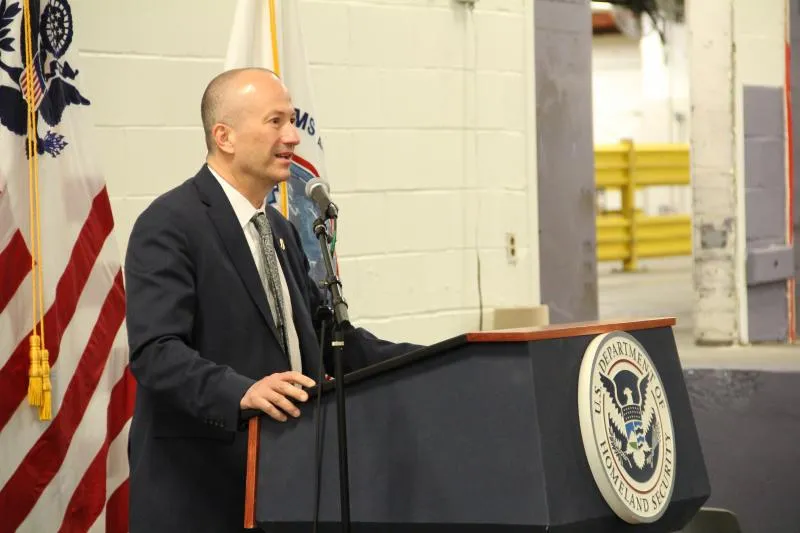CBP’s Federal Inspection Site Gets a Makeover
JAMAICA, N.Y. – The International Mail Facility (IMF) at John F. Kennedy International Airport (JFK) underwent a multi-million-dollar renovation with Executive Assistant Commissioner William Ferrara and the Senior Official Performing the Duties of the Commissioner Troy Miller overseeing a ribbon-cutting ceremony on April 9.

Commissioner Troy Miller.
“I am immensely proud to cut this ribbon and step into a new era of narcotics detection and border security. This redesigned space and the new IDSS machines will be critical in our effort to identify and disrupt the transnational criminal organizations who ship these deadly drugs through our international mail system. I am pleased by the outstanding work that happens in this building day in and day out, from countless narcotic seizures to keeping up with the explosive growth of e-commerce before and during the COVID-19 pandemic. I look forward to seeing what will develop with this new technology, said Mr. Troy Miller, Senior Official Performing the Duties of the Commissioner.”
“Unfortunately, narcotic death rates continue to grow annually, said Executive Assistant Commissioner William Ferrara. We must continue to combat narcotics trafficking through the mail by Transnational Criminal Organizations. CBP must remain focused on optimizing our processes to detect, hold, and seize suspicious mail. We are excited about the renovated International Mail Facility, which will not only increase inspection efficiency, but also strengthen our border security mission.”
“This ceremony highlights how CBP remains committed to being innovative and forward-thinking in our pursuit to advance national security and facilitate lawful trade, all while fulfilling our agency’s mission. We have faced an uphill battle in the fight against the importation of illegal narcotics yet from this day forward, we will change that trajectory,” said Acting Director, New York Field Operations, Marty C. Raybon.
The ceremony was preceded by a tour of the newly remodeled IMF, with live displays put together by CBP’s Canine, Agriculture, and Intellectual Property Rights teams. The live displays were followed by demonstrations and briefings provided by several of the law enforcement partners CBP works alongside of daily, including the Food and Drug Administration (FDA), United States Fish and Wildlife Service (FWS), Homeland Security Investigations (HSI) and Laboratories and Scientific Services (LSS), and the ceremony concluded with speeches from Mr. Ferrara and Mr. Miller.
The IMF at JFK processes more than half of all the incoming international mail into the United States, roughly one million international letters/packages/parcels, etc. daily. U.S. Customs and Border Protection’s (CBP) efforts to interdict opioids and other illicit drugs being sent through the U.S. Postal Service (USPS) have been widely successful, however there is always room for improvement. In 2019, CBP had 8,000 drug seizures, which totaled more than 8,000 lbs. of drugs. In 2020, the number of seizures by CBP nearly doubled to 15,000 seizures. Despite CBP’s best efforts, illicit drugs were still entering the United States. After careful consideration, CBP determined that improving their technological detection systems was the next step forward.
According to the Centers for Disease Control and Prevention (CDC), in 2018, more than 67,000 Americans were reported to have died due to an opioid overdose, Fentanyl deaths rose almost 12 times since 2013. From 1999 to 2018, nearly 450,000 people died from an overdose due to opioid use; 36,000 of those used synthetic opioids such as fentanyl. Much of the opioids consumed in the U.S. are obtained illegally from places like the Dark Web and sent through the mail. Their size and shape make opioids easily packed into unintrusive, low-weight small packages.
In 2017, United States Congress passed the Synthetics Trafficking and Overdose Prevention Act, known as the STOP Act, with the intention of assisting the USPS and CBP in the prevention of illicit substances from entering the U.S. via international mail.
The U.S. government sponsored the Opioid Detection Challenge as a way to test and acquire the most advanced technology. So, in 2019 from February through December the challenge had an award total of $1.55 million in cash prizes. With an initial number of entrants at 83 from more than 10 countries, outreach from the global marketing approach levied over 1,200 collaborators and solvers.
The Challenge was split into two stages with judges keyed in on specific technologies. In the first stage, the criteria consisted of: accuracy, speed, feasibility, usability, flexibility and, the team. In the second stage, they focused in on some new categories: accuracy, speed, reliability, scalability, usability, and threat adaptability.
At the end of stage one, in June, eight finalists were selected, and they shared a prize pool of $800,000, allotting each entrant $100,000. Stage two had a prize of $750,000 that was shared by the grand prize winner with $500,000 and the runner up with $250,000.
- Grand prize: Scanner and Algorithms for Automatic Opioid Detection (IDSS Holdings)
- Runner up: Nonimaging Concealed Drugs Detector (One Resonance)
- Finalists: Dynaxion, Battelle, HALO X-ray Technologies, GTBM, Inc., Vadum, Inc., and XIS, LLC.
CBP plays a critical role in the Nation’s efforts to keep dangerous drugs from harming the American public. The CBP Strategy to Combat Opioids serves as an action plan identifying what CBP will accomplish with our partners in aggressively identifying and disrupting the illicit opioid supply chain.
To learn more about what CBP does to protect the United States border from illicit narcotics please visit: Fact Sheets | U.S. Customs and Border Protection (cbp.gov)

